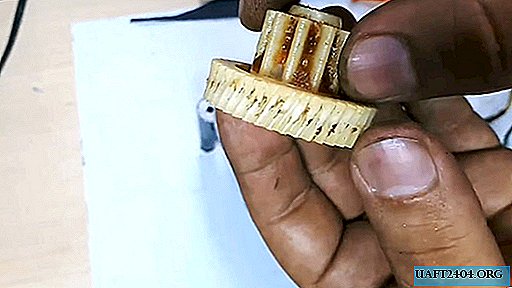Share
Pin
Tweet
Send
Share
Send

Good afternoon! Now we will assemble a low-frequency amplifier. Based on the chip TDA2004.

It has two outputs, but the power of each individually is 8 watts, and this is not so much. Therefore, we will use bridge switching. Such inclusion will increase the power by more than two times.
Amplifier specifications
So, the main characteristics of our amplifier:
- Supply voltage: 8-18 volts;
- Rated output: 20 watts;
- Maximum power output: 25 watts.
The scheme is as follows:

Necessary Details
- DD.1 - TDA2004;
- C1, C2, C3, C7, C8 - 0.1 μF;
- C4 - 470 uF, 25 Volts;
- C5 - 10 uF;
- C6 - 1 nF;
- R1 - 470 ohms;
- R2, R3 - 22 Ohms.

Printed circuit board
For a printed circuit board, we need a piece of PCB with a size of 3x2 cm, as well as a board drawing:
pp.zip 33.05 Kb (downloads: 175)

Production of a low frequency amplifier
We cut and transfer with the laser-iron method. Everything that has not been fully transferred is finished with varnish.

We will pickle in a solution of hydrogen peroxide and citric acid. Pour three tablespoons of peroxide into a large disposable cup, pour a tablespoon of citric acid and add a pinch of ordinary salt, it is a catalyst, and is not consumed during the reaction. We mix the solution until the substances are completely dissolved and throw the board there. Hydrogen bubbles begin to stand out, and the solution turns blue.

The board is poisoned for about half an hour. You can speed up the process a little by putting the solution in the sun.
When the excess copper dissolves, we take out the board and rinse it with water.

The used solution should be poured into the general sewer.
Next, use acetone to clean the board from the toner and tin track.

First, solder the microcircuit in its place, then the remaining components.
Install, focusing on the picture:

At this stage, the amplifier is ready. Before turning on the chip should be installed on the heat sink.


Here's a compact, but rather powerful amplifier. I connected a 25 Watt 4 Ohm woofer to it - it did fine, at full volume no wheezing, clicks or other sound distortions were observed. For an hour of operation, the radiator warmed up to 60 degrees.
And on this my article came to an end, good luck to everyone in the repetition!
Share
Pin
Tweet
Send
Share
Send











